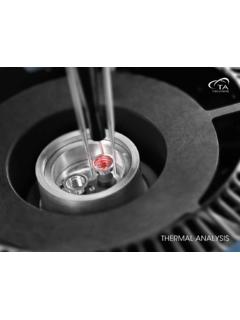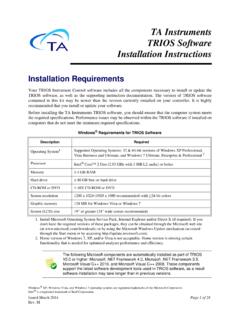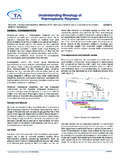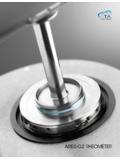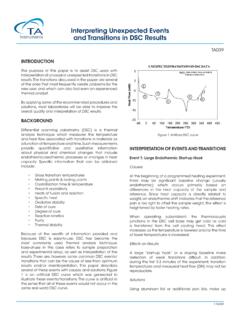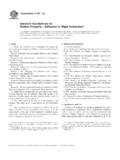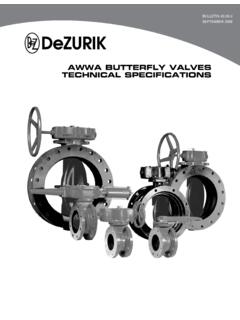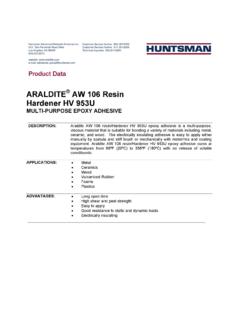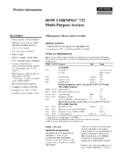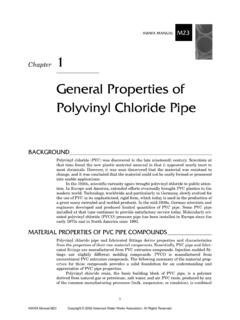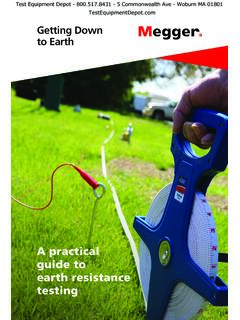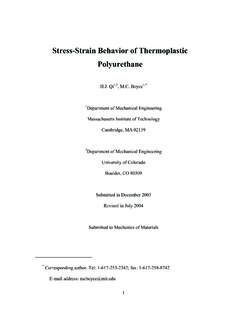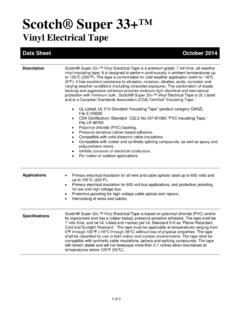Transcription of Introduction to Dynamic Mechanical Testing for Rubbers and ...
1 To Dynamic Mechanical Testing for Rubbers and ElastomersMackenzie GeigerApplications ScientistSeptember 6, DMA Thermal Analysis or Rheology?Definitions Thermal Analysis measurement as a function of temperature or time. Rheology the science of stressand deformationof matter. DMAis the general name given to an instrument that mechanically deforms a sampleand measures the sample response. The response to the deformation can be monitored as a function of temperature or can be Studied with DMA? Composition Degree of cross-linking Comparison of crystallinity levels Molecular Orientation effect of Filler Physical Properties Prediction of impact resistance Testing of creep or cold flow Stress relaxation behavior Cure behavior Viscoelastic Properties Storage Modulus Loss Modulus Tan Delta Glass Transition (Tg) Sub-Tgmolecular motions (beta and gamma relaxations) Lifetime predictions using Time Temperature does a DMA do?
2 Measures the Mechanical properties of a sample as it is deformed over a range of stress, strain, timeand temperature Can either apply Stress(Force) and measure Strain(Displacement), or apply Strainand measure Stress Determines the Modulusof the material (Stress/ Strain) Controls the Frequency(Time) of the deformation to measure viscoelastic properties (Storage Modulus, Loss Modulus, Tan Delta) Temperaturecontrolled in heating, cooling, or isothermal modes Modes of Deformation: Tension, Bending, Compression and Shear Modes of Deformation Film/FiberCompression3-Pt BendingCantileverShear SandwichContact does a DMA work? Stress (Pa) = Force(N)Area(m2)Strain = Deformation(m)Length(m)Modulus (Pa) = Stress(Pa)Strain The DMA measures raw instrument signals Force, Displacement, Stiffness Dimensions of the sample are recorded Length, Width, Thickness Software calculates Mechanical parameters Stress, Strain, Modulus Viscoelastic ParametersThe Elastic (Storage) Modulus:Measure of elasticity of material.
3 The ability of the material to store Viscous (loss) Modulus:The ability of the material to dissipate energy. Energy lost as Modulus:Measure of materials overall resistance to Delta:Measure of material damping -such as vibration or sound =Stress Straincos E"=Stress Strainsin E =Stress Straintan =E"E Measurements Torsion and DMA geometries allow solid samples to be characterized in a temperature controlled environmentRectangular and cylindrical torsion DMA 3-point bending and tension(Cantilever not shown)Modulus: G , G , G*Modulus: E , E , E*E = 2G(1 + ) : Poisson s DMA DataTerminal RegionRubbery PlateauRegionTransitionRegionGlassy RegionLoss Modulus (E" or G")Storage Modulus (E' or G')Very hard and rigid solidStiff to Soft rubberViscoelastic liquidTemperature/ of DMA Understanding the Glass Transition Measuring Transitions in DMA Viscoelastic properties and the Glass Transition Testing considerations Secondary Transitions Material properties and the Glass Transition Molecular Structure, Composition, Environmental Effects Other Glass Transition A transition over a range of temperature from a glassy state to a rubber state in an amorphous material Mechanical .
4 Below the Glass Transition, the material is in a brittle, glassy state Above the Glass Transition, the material becomes soft and flexible, and a modulus decrease. Molecular: Below the Glass Transition, polymer chains are locked in place, without sufficient thermal energy to overcome the barrier for rotational or translational motion. At temperatures above the Glass Transition, there is molecular mobility, and chains can slide past each Glass Transition The glass transition is associated with the onset of long-range cooperative segmental mobility in the amorphous phase, in either an amorphous or semi-crystalline polymer. Any factor that affects segmental mobility will affect Tg, the nature of the moving segment, chain stiffness or steric hindrance the free volume available for segmental motionTuri, Edith, A, Thermal Characterization of Polymeric Materials, Second Edition, Volume I.
5 , Academic Press, Brooklyn, New York, P. Transition E' Onset, E" Peak, and Tan Peak Storage Modulus E' Onset: Occurs at lowest temperature, relates to Mechanical failureTuri, Edith, A, Thermal Characterization of Polymeric Materials, Second Edition, Volume I., Academic Press, Brooklyn, New York, P. 980. Tan Peak: Occurs at highest temperature; Used historically in literature Measure of the "leatherlike" midpoint between the glassy and rubbery states Height and shape change systematically with amorphous content. Loss Modulus E" Peak: Occurs at middle temperature Related to the physical property changes Reflects molecular processes -the temperature at the onset of segmental motion Transition of Polycarbonate: E , E , Tan Sample in Bending on DMA Q800llllllllllllllppppppppppppppp [ ] Tan Delta 110100100010000[ ] Loss Modulus (MPa)p110100100010000[ ] Storage Modulus (MPa)l-100-75-50-250255075100125 Temperature ( C)Sample: Black RubberSize: x x mmMethod: Temperature RampComment: ULSP chiller, screenDMAFile: : EPRun Date: 12-Jul-2013 06:39 Instrument.
6 DMA Q800 Build 50 Universal TA Chiller System (ACS)InstrumentEnvironmental SystemMinimum TemperatureACS-2 ACS-3 DMA Q800 Standard Furnace-50 C-100 CARES-G2/RSA-G2 Forced Convection Oven, FCO-55 C-100 CDHR-1, 2 or 3 Environmental Test Chamber, ETC-50 C-85 of EPDM Rubber by DSC & Sweep The material response to increasing frequency (rate of deformation) is monitored at a constant amplitude and temperature. TimeDeformationUSES High and Low Rate (short and long time) modulus properties. Polymer melt processing (shear sandwich). Extend range with Sweep: Material ResponseTerminal RegionRubbery PlateauRegionTransitionRegionGlassy Region12 Storage Modulus (E' or G')Loss Modulus (E" or G")log Frequency (rad/s or Hz) Structure -Crosslinking Linear polymers can be chemically or physically joined at points to other chains along their length to create a crosslinkedstructure Chemically crosslinkedsystems are typically known as thermosetting polymers because the crosslinking agent is heat , , Hadley, , An Introduction to the Mechanical Properties of Solid Polymers, John Wiley & Sons Ltd.
7 , New York, Cure of RubberFull cureRubber VulcanizationShear Sandwich ClampFrequency: 1 HzAmplitude: 20 Molding Compound Cure in Shear [ ] Temperature ( C) [ ] Loss Modulus (MPa) Modulus (MPa)010203040506070 Time (min)Sample: Sheet Molding CompoundSize: x x mmMethod: Temp Ramp/Single FreqComment: 1 Hz, 20 micronsDMAFile: C:..\DMA\Winona\ : RRURun Date: 17-Nov-99 09:08 Universal TA InstrumentsFrequency = 1 HzAmplitude = 20 Compound: effect of Curing Temperature145 C140 C135 C130 C125 C120 CTime (min) of Crosslinking1201603001500900030,000M = MW of Crosslinking on TgIncreasing CrosslinkingHigher Density Less Free Volume Restricted molecular motionMore Energy neededHigher Glass Transition TemperatureCowie, , Polymers: Chemistry & Physics of Modern Materials, 2nd Edition, Blackie academic & Professional, and imprint of Chapman & HallBishopbriggs, Glasgow, 1991 ISBN 0 7514 0134 XFor low values of crosslink density, Tgcan be found to increase linearly with the number of crosslinks.
8 For high crosslink density, the Tgis broad and not well , Molecular Weight, and CrosslinkingIncreasing MWCross-linkedAmorphousCrystallineIncrea sing CrystallinityTmTemperaturelog Modulus3 decade dropin modulus at of Molecular Weight Molecular Weight has practically no effect on the modulus below Tg. Tgand the drop in modulus are also nearly independent of MW if the MW is high enough to form entanglements The rubbery plateau region above Tgis strongly dependent on MW. In the absence of true crosslinks, the behavior is determined by entanglements. The length of the rubbery plateau (Tg Tm) is a function of the number of entanglements per , Lawrence E., Mechanical Properties of Polymers and Composites, Marcel Dekker, Inc.
9 , New York, 1974, p. of % Crystallinity on Modulus The major effect of the crystallite in a sample is to act as a crosslink in the polymer matrix. This makes the polymer behave as though it was a crosslinkednetwork, but as the crystallite anchoring points are thermally labile, they disintegrate as the temperature approaches the melting temperature, and the material undergoes a progressive change in structure until beyond Tm, when it is molten Cowie, , Polymers: Chemistry & Physics of Modern Materials, 2nd Edition, Blackie academic & Professional, and imprint of Chapman & HallBishopbriggs, Glasgow, 1991p. 330-332. ISBN 0 7514 0134 XRandom Chain100% AmorphousFringed DMA allows users to obtain Mechanical properties over a wide range of temperatures Example: Tires in a variety of environmental conditions Resolve weak glass transitions that may otherwise go undetected in other techniques Tan as a means to explain energy dissipation of Rubbers and YouThe World Leader in Thermal Analysis, Rheology, and Microcalorimetry
